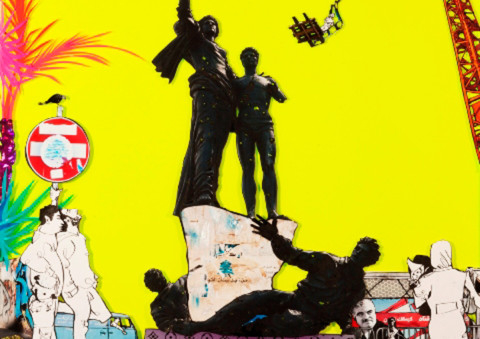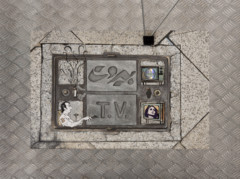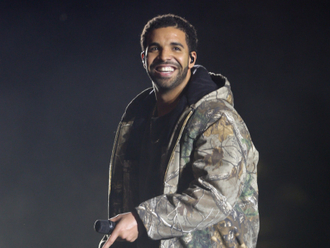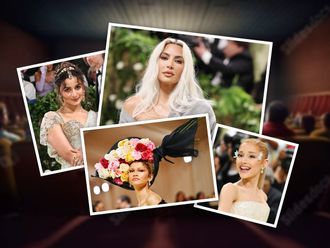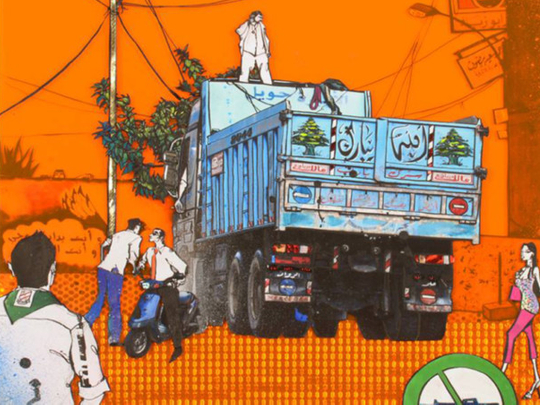
On her first trip to Beirut a year ago, Hatty Pedder was overwhelmed, confused and intimidated by the complexity and chaos. But on subsequent visits she developed a better understanding and appreciation of the city, the people and the undercurrents.
The Dubai-based British artist has captured the ethos of the city in her latest series of mixed-media works, titled “Khosh Bosh! Beirut – An Identity Adrift”.
“Khosh Bosh” is a Lebanese slang phrase that refers to a relationship without inhibitions or protocol, and it describes perfectly Pedder’s own relaxed relationship with the city now, and the spirit and tone of her work.
“Beirut has so many layers, and is so full of contradictions and contrasts, that it took me some time to absorb it all. I have tried to show the multi-ethnic, multi-religious mix of people who live in the city, the rampant consumerism, the lifestyle and attitude of the people, the architecture, the history and the culture.
The idea was to explore the multiple identities of a city which has been constantly redefined by civil strife, external manipulation and hidden political agendas, and I have experimented with new concepts, media and materials to do this,” Pedder says.
She has used a combination of drawing, painting and photographs to create photomontages depicting different aspects of the city. Her carefully constructed images and narratives are filled with humorous and insightful references to issues ranging from people’s obsession with designer brands, plastic surgery and pampered pets to the lack of electricity and parking space in the city.
In one set of works, photographs of manholes are mounted on matching grey aluminium sheets. Images of men and women in designer clothing and accessories, talking on their mobile phones, surfing channels on television or hanging out on their balconies during a powercut are embedded in the manholes to present a slice of daily life in Beirut. “I loved the look of the manholes and wanted to use them in my work. And I put silver leaf on the images and encrusted the designer accessories and even some of the plants with crystals to show the contrast between the grit and glamour in the city,” Pedder says.
The large mirrors installed all over the city to help drivers navigate the chaotic traffic also caught her eye. She has used them to create a set of acrylic-on-mirror paintings called “Allah Yestor!” Protective symbols, such as the evil eye, the hand of Fatima and a bird, painted on the mirrors comment on the plight of motorists and pedestrians in the city.
Pedder reflects on the past in a piece named “Beyrouth”, featuring the picture of an elegant woman, placed in a flamboyant frame, covered with vintage newspapers. “Beirut used to be called the Paris of the Middle East and the Lady of Lebanon. This woman represents the pure and beautiful lady draped in the cloak of events that shaped her life. The composition is inspired by a photoshoot done in Beirut in the 1960s by a famous photographer. And I have used Arabic, French and English newspapers with articles about past and current events,” she says.
The artist pays tribute to the city’s cultural heritage through a set of digital paintings on mirrors dedicated to Khalil Gibran and his writings; a collection of pop-art style reproductions of old Lebanese stamps, featuring traditional costumes; and a depiction of a much-visited religious monument, complete with candles and flowers placed inside the frame.
Pedder recounts the city’s history through images of bullet-ridden statues of martyrs, the statue of an assassinated journalist and the 1960s City Centre building popularly known as The Egg.
“By showing people smoking shisha, walking their bejewelled dogs, or posing on the red carpet in glamorous designer clothes around these monuments, I wanted to show that despite all the conflicts life goes on in Beirut. The Egg is the only building remaining from the internationally acclaimed avant-garde modernist movement of the 1960s in Beirut. And one cannot help wondering whether its popular name refers to the shape of the egg or its fragility,” she says.
In other light-hearted works you can see the famous Beirut taxis with one hand of the driver dangling outside the window, and other everyday scenes on the streets. Here the artist has used multiple layers of acrylic to create depth in her collages, which convey the contrasts between dressing styles of conservative Muslim women and flamboyant fashionistas; old buildings being demolished and flashy new constructions; the ubiquitous shisha cafés and military checkpoints; the tangles of electrical cables everywhere and the indispensable power generators; the graffiti and the posters of local celebrities and politicians and the highly visible international brands; and much more.
“I had to use bright colours and bling up everything because Beirut is such a vibrant, glitzy, positive place, with incredible people who know how to live in the moment. It has been a wonderful journey of exploration and I enjoyed putting together my experiences to tell this story,” Pedder says.
Jyoti Kalsi is an arts enthusiast based in Dubai.
The show will run at Mojo gallery, Al Quoz, until October 31.


